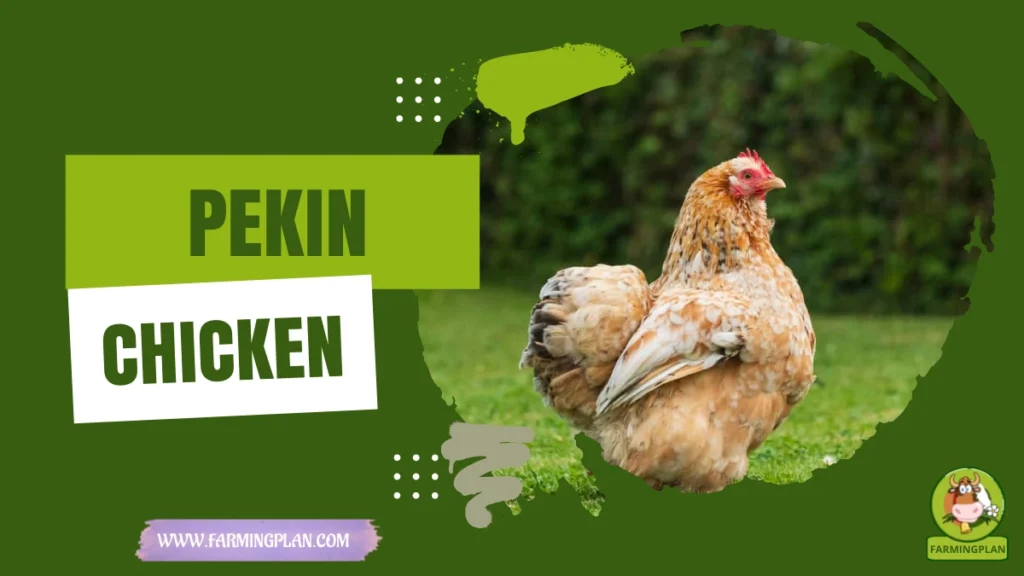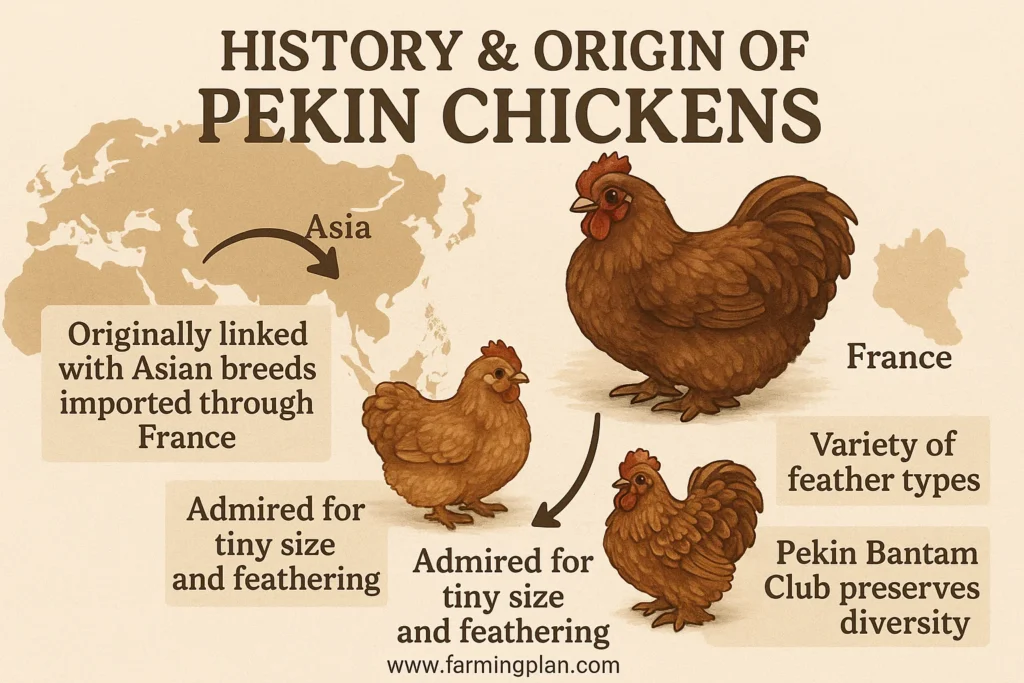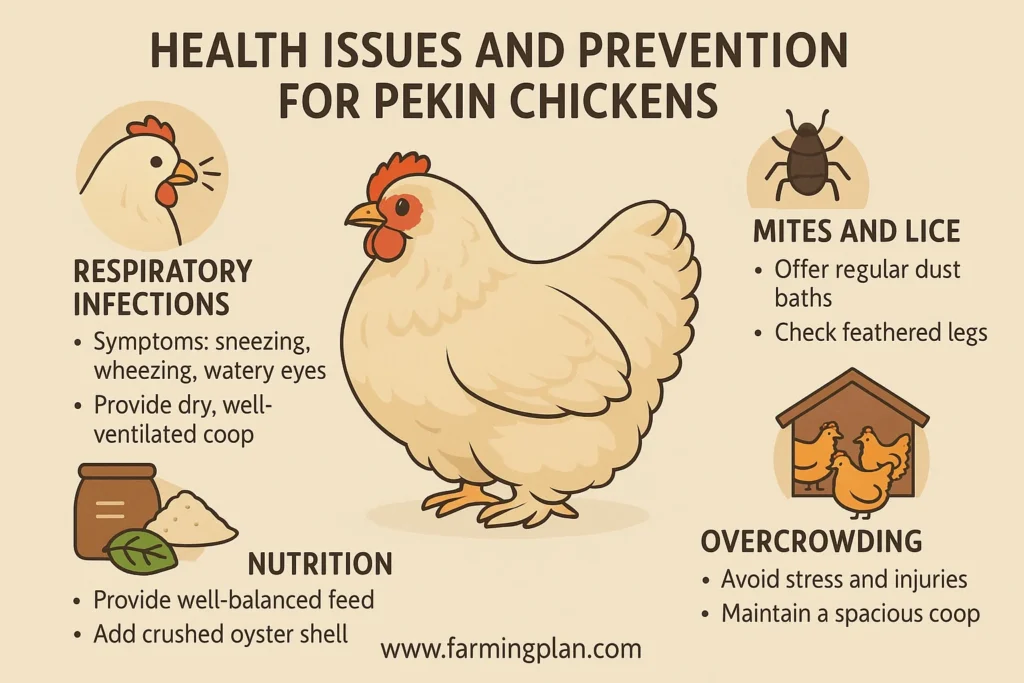If you’re thinking about adding a delightful feathered friend to your backyard, let me introduce you to the Pekin chicken. These bantam beauties are some of the most captivating creatures I’ve had the pleasure to raise. With their lovely feathers, sweet personalities, and variety of colors—like Silver Partridge and Gold Partridge—they make perfect companions whether you’re a beginner or a seasoned chicken keeper. In this article, I’ll share everything I know about the Pekin chicken breed, from its history and special features to how to keep it healthy and happy in your flock. So, whether you want bantam Pekins for pets, egg-laying, or just to admire, I’m here to guide you through this charming chicken adventure!

History & Origin of Pekin Chickens
The Pekin chicken has an intriguing past that ties back to early trade routes and some unlikely historical connections. Originally, these birds are believed to have roots linked with Asian breeds imported through France, which explains their sometimes called “Peking” chicken breed name. They caught the eye of French forces and chicken lovers alike, who admired their tiny size and distinctive feathering. Over the years, breeders refined these birds into the true bantams we know today, recognized for their miniature size and elaborate plumage.

What sets Pekin Bantams apart is not just their size but their unique feathering. The breed boasts an impressive variety of feather types, including frizzled and smooth feathers, and their tail feathers are often quite elaborate. The Pekin Bantam Club meticulously preserves the rich diversity within the breed, making it a fascinating subject for anyone intrigued by bantam chickens.
Reads More: Goat Diseases Prevention: Essential Tips To Protect Your Herd
Characteristics of Pekin Chickens
When it comes to physical features, Pekin chickens truly stand out. They are small but sturdy, a classic example of a miniature chicken that packs a lot of personality into a little body. Their feathers are thick and soft, covering their legs and feet in a fluffy display that adds to their charm. You’ll often see different color variations like the dazzling Silver Partridge, the warm Gold Partridge, and some rarer, eye-catching lines that breeders treasure.
Besides their physical beauty, these bantam chickens have a variety of personalities, from curious and active to calm and affectionate. The hens tend to be quieter and have excellent layers, producing eggs that are just as special as the birds themselves. If you ever meet a Pekin bantam hen or a sprightly pekin cockerel, you’ll notice how their individual traits shine through. I’ve found that understanding these nuances helps me keep my flock happy and balanced.
Nature and Temperament of Pekin Chickens
One of the reasons I recommend Pekin chickens to almost every beginner is their wonderful nature. These birds are famously docile and friendly, making them great companions for families and small farms alike. Unlike some larger or more flighty breeds, bantam Pekins are quite happy to be handled and often enjoy the company of humans.
Their personalities can be quite charming—some are playful, others a bit shy, but all bring a delightful spark to the backyard. From experience, they get along well with other chicken breeds and rarely cause trouble. For anyone worried about aggression or managing a peaceful flock, Pekins offers a gentle alternative. Their quiet clucks and social behavior make them ideal pets for families with kids or first-time chicken parents.
Food and Diet for Pekin Chickens
Keeping your Pekin chickens healthy means feeding them well. These bantams aren’t picky, but they do thrive on a balanced diet rich in protein and vitamins. I always recommend a high-quality poultry feed as the base, supplemented with fresh produce like leafy greens and occasional treats like mealworms to keep them excited at feeding time.

Feeding your Pekin chickens a balanced diet is crucial for their health and well-being. While they aren’t picky eaters, they do thrive on a diet rich in protein and vitamins. High-quality poultry feed supplemented with fresh produce and occasional treats like mealworms keeps them excited at feeding time. Remember, avoiding junk food is crucial; unhealthy diets can quickly lead to issues, especially in smaller birds. Fresh water is non-negotiable—these little guys drink quite a bit to maintain their lovely feathers and energy. When my Pekins eat well, their egg production and feather quality improve dramatically. So, feeding right isn’t just about survival; it’s about keeping your flock vibrant and lively.
Usage and Purpose of Pekin Chickens
What can you do with Pekin chickens besides admire their fluff and charm? Well, they make splendid pets, show birds, and even egg producers. While they don’t lay as many eggs as larger breeds, the eggs they produce are a delightful bonus—small but perfectly formed. Many backyard chicken keepers love them as companions, thanks to their manageable size and sweet dispositions.
For show enthusiasts, Pekins offer endless variety and beauty to exhibit, especially those with rarer colors or feather types. They also serve as excellent starters for beginners eager to enter the world of chicken keeping. In all my years working with these birds, I’ve found their versatility to be a huge benefit, whether you want a lovely flock for fresh eggs, fun, or family pets. Their adaptability and charm make them a delightful addition to any flock.
“The Secret To Happy Pekin Chickens Is Consistent Care And A Lot Of Loving Attention.“
Special Features of Pekin Chickens
Pekin chickens have some truly unique features that set them apart from other bantams. Their fluffy feathers cover even their legs and feet, creating an elegant and unusual look. You’ll see varieties like the frizzled Pekins, whose feathers curl outwards for a wild and whimsical appearance. Their elaborate tail feathers add to their charm, especially in roosters.
Breed enthusiasts often debate about the best feather colors and types, making it a contentious issue among clubs and breeders. But this diversity also makes Pekins endlessly fascinating to raise. Their individual personalities shine through their splendid feathers and friendly attitudes. Honestly, these traits make every day with them an adventure.
Health Issues and Prevention for Pekin Chickens
Over the years, I’ve learned that keeping Pekin chickens healthy takes more than just feeding them well—it’s about observation, cleanliness, and good habits. One of the most common issues I’ve dealt with is respiratory infections. These can sneak up fast, especially in damp or poorly ventilated coops. If you ever hear sneezing, wheezing, or notice watery eyes, don’t wait—separate the bird and consult a vet or experienced keeper. To prevent these problems, I always make sure my coop has good airflow without drafts and stays dry, even after heavy rain.

Feathered legs may be part of what makes Pekins so adorable, but they also make them more vulnerable to mites and lice. These pests hide in their fluffy feathers and can cause discomfort, weight loss, or worse if ignored. I swear by regular dust baths filled with a mix of clean dirt, wood ash, and a sprinkle of diatomaceous earth. It helps the birds keep themselves clean and pest-free. I also do occasional leg checks—just a quick once-over to spot any scaly buildup or redness.
Nutrition plays a big part in disease prevention, too. A well-balanced feed keeps their immune system strong and helps them resist common illnesses. I always add crushed oyster shell on the side for calcium and make sure they get fresh greens and occasional treats. Avoid overcrowding your coop—it’s a common practice among backyard chicken keepers to add “just one more,” but too many birds in a small space can lead to stress, injuries, and sickness. From what I’ve seen, a clean, calm, and spacious environment makes all the difference in keeping a lovely flock of healthy birds.
Reads More: Amazing Miniature Horse Care: Your Ultimate Friendly Guide
Step-by-Step Care Guide for Pekin Chickens
Step 1: Set up a cozy chicken coop.
Make sure your coop is safe, dry, and sized for bantam chickens. Pekins love clean bedding, so use soft straw or wood shavings. Because they have feathered feet, avoid damp conditions to prevent infections.
Step 2: Provide a balanced diet daily.
Feed a high-quality poultry feed designed for bantams, plus fresh veggies and clean water. Watch their eating habits—healthy Pekins are active and alert.
Step 3: Maintain daily care routines.
Check your flock every day for signs of health issues. Clean the coop weekly, refill water and food, and spend time socializing with your birds to keep them friendly and calm.
Step 4: Collect eggs regularly and manage hens carefully.
Though bantam hens lay fewer eggs, collecting them daily prevents breakage and keeps your coop tidy.
Step 5: Seasonal protection.
In cold months, add extra bedding and shelter from drafts. In hot weather, provide shade and plenty of water to keep your Pekins cool and comfortable.
Expert Tips & Best Practices for Pekin Chickens
One of the most valuable things I’ve learned over the years with Pekins is that they absolutely love consistency. Chickens are creatures of habit, and Pekins are no different. They thrive when they have a steady daily routine—same feeding times, same cleaning schedule, and even the same human faces around them. When they feel safe and settled, they’re far more likely to be friendly, lay regularly, and stay healthy. If you can build those habits early, it’ll save you a ton of trouble down the road.
Another golden rule? Keep their coop clean and cozy. Pekin chickens have fluffy feathered feet that can easily get caked with mud or poop, especially in damp weather. Regularly check their legs and toes to avoid infections or mites. I like to use sand in their run because it drains better and helps keep things cleaner. Oh, and don’t forget—bathing your Pekins occasionally is a thing. It’s not just for show birds! A gentle warm rinse can help if their feathers get really dirty.
And here’s a little secret I picked up from an old poultry show friend: treat your Pekins like tiny feathered royalty. Give them treats (in moderation), talk to them, and make their coop feel like a safe, relaxing retreat. Some owners even play soft music in the coop! The more relaxed and loved they feel, the better they’ll behave—and the more eggs they’ll give you. It’s funny how a little affection goes a long way with these charming birds.
Tip: The Secret To Happy Pekin Chickens Is Consistent Care And A Lot Of Loving Attention.
Where to Buy Pekin Chickens
So you’re convinced—Pekin chickens are the right choice, and now you’re wondering where to get them. The good news is, there are tons of options, whether you’re just getting started or adding to an existing flock. One of the most reliable places to start is your local poultry show or bantam club. These groups often have breeder directories and can help connect you with reputable sellers who specialize in healthy, well-raised birds. Plus, you get to see the birds in person and talk shop with fellow chicken lovers.
If you prefer to shop online (especially if you’re in a rural area), there are many hatcheries and breeders with websites where you can browse photos, read about each chicken’s lineage, and even reserve specific colors or feather types. Just be careful to double-check that you’re getting Pekin chickens—some folks mix them up with Pekin ducks, which are a whole different species! Reading reviews and asking questions before buying can save you from a lot of headaches.
Another helpful tip: follow breeder pages or poultry forums on social media. People often post when they have chicks available, and you can sometimes get alerts about seasonal discounts or shipping deals. Also, don’t overlook farm supply stores or local classifieds—occasionally, you’ll find hidden gems right in your area. Just make sure the birds you choose are alert, active, and free from obvious health issues. Bright eyes, smooth feathers, and clean feet are all signs of a happy, healthy chicken ready to join your backyard crew.
FAQs
How big do Pekin chickens get?
Pekin bantams are small, usually weighing about 1 to 2 pounds, making them perfect for small backyards.
Do Pekin chickens lay many eggs?
They lay fewer eggs than larger breeds, but their eggs are cute and often rich in flavor.
Are Pekin chickens good pets for kids?
Yes! Their gentle and friendly nature makes them ideal for families and first-time chicken keepers.
Can Pekins live with other chicken breeds?
Absolutely. They generally get along well with other breeds and are not aggressive.
What kind of coop do Pekins need?
A clean, dry coop with plenty of space, soft bedding, and good ventilation works best for their feathered feet.
Conclusion
You will have fun and plenty of happy times while raising Pekin chickens. Because they are friendly, easy to care for and have fine feathers, backyard chicken keepers and families find them suitable pets. Healthy, kind care, the right diet and paying attention to health issues in your chickens should lead to happy, healthy birds and eggs every day. Do you want to begin with a few chickens or have an extensive farm? Pekins will always entertain you. You’ll find that once you have these bantams, they’ll be the highlight of your yard.

